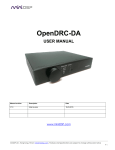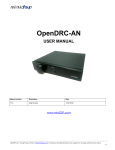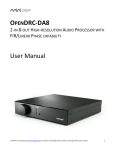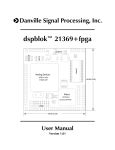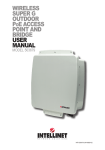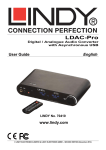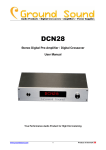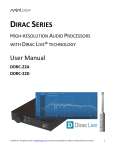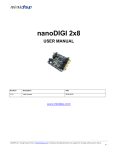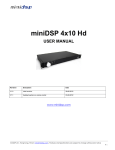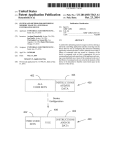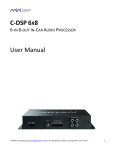Download OpenDRC-DI User Manual
Transcript
OpenDRC-DI USER MANUAL Manual revision Description Date V1.0 Initial revision 18-02-2012 V1.1 Firmware upgrade information 18-04-2012 V1.2 DSP upgrade step by step 17-07-2012 www.miniDSP.com miniDSP Ltd – Hong Kong / Email : [email protected] / Features and Specifications are subject to change without prior notice P1 Contents 1 2 3 4 5 6 Product Introduction ..............................................................................................................................................................................................3 System Connectivity ...............................................................................................................................................................................................5 2.1 Connectivity .....................................................................................................................................................................................................5 2.2 Typical setup ....................................................................................................................................................................................................5 2.2.1 DC Power connectivity........................................................................................................................................................................6 2.2.2 Digital Audio connectivity...................................................................................................................................................................6 Software Setup ........................................................................................................................................................................................................7 Plug-in Architecture – OpenDRC 2x2...................................................................................................................................................................9 4.1.1 Main Page .............................................................................................................................................................................................9 4.1.2 Preset Memory selection .....................................................................................................................................................................9 4.1.3 Main Tab ................................................................................................................................................................................................9 4.1.4 Input channel mode..........................................................................................................................................................................10 4.1.5 Parametric Equalizer ..........................................................................................................................................................................10 4.1.6 FIR (Finite Impulse Response) filter section......................................................................................................................................11 4.1.7 Output Section....................................................................................................................................................................................12 4.2 Load/Save/Restore a configuration...........................................................................................................................................................14 4.2.1 Load configuration: ...........................................................................................................................................................................14 4.2.2 Save configuration.............................................................................................................................................................................14 4.2.3 Restore current configuration only ..................................................................................................................................................14 4.2.4 Restore Factory default .....................................................................................................................................................................14 4.3 IR remote learning feature...........................................................................................................................................................................14 4.4 Firmware upgrade.........................................................................................................................................................................................15 Technical Specifications ......................................................................................................................................................................................16 Troubleshooting.....................................................................................................................................................................................................18 miniDSP Ltd – Hong Kong / Email : [email protected] / Features and Specifications are subject to change without prior notice P2 1 Product Introduction The OpenDRC is a Digital Audio Signal Processor (DSP) capable of performing a wide range of processing including filtering (FIR + IIR), compression/limiter, time alignment.. Typically located between an audio source (CD player/Receiver/Preamp/PC .. etc) and the amplifier, the OpenDRC will provide unparalleled tuning flexibility to improve your audio system’s performance. Using a PC/Mac machine and a USB connection, you will be able to control your platform from the “plug-in”: an intuitive software application allowing real time modification to your configuration. Besides its audio specs, a great part of our product concept lies in its simplicity of use. The sequence of steps required to control the unit can be summarized as follow: Connect the board to your PC/Mac machine using a USB cable Launch the plug-in to configure settings as required. Click “Connect & Synchronize” your PC to the board Once synchronized, any change is real time and does not require any “Synchronization”. All settings are also automatically saved to both the DSP and the Flash for long term memory. Once happy with your configuration, you can disconnect the board from your computer since from this point on, the audio configuration will run as last modified in on-line mode and recalled following every reboot. Enjoy! Minimum System Requirements for software installation The software minimum requirements are as follow: PC Environment 1. PC with 1GHz or higher processor clock speed recommended / Intel® Pentium®/Celeron® family, or AMD K6®/AMD Athlon®/AMD Duron® family, or compatible processor recommended. 2. 512 megabytes (MB) of RAM or higher recommended 3. USB 2.0 port 4. Keyboard and mouse or compatible pointing device 5. Microsoft• ® Windows® Vista® SP1/ XP pro SP2/Win7 6. Microsoft• ® .NET framework v3.5 7. Adobe AIR environment (latest version) 8. Adobe Flash player (latest version) MAC Environment 1. Intel based MAC with 1GHz or higher processor clock speed recommended 2. 512 megabytes (MB) of RAM or higher recommended 3. USB 2.0 port 4. Keyboard and mouse or compatible pointing device 5. Mac OSX 10.4 or higher 6. Adobe AIR environment (latest version) 7. Adobe Flash player (latest version) Package content Your OpenDRC-DI package includes: • 1 x OpenDRC-DI unit • 1 x USB cable Type B • 1 x Optical cable • 1 x 5VDC universal power supply with interchangeable plugs for US, UK, EU, AU • 1 x short step by step startup guide miniDSP Ltd – Hong Kong / Email : [email protected] / Features and Specifications are subject to change without prior notice P3 DISCLAIMER / WARNING An incorrect DSP configuration could easily damage your audio system. miniDSP Ltd can not be responsible for any damage that may result from the improper use of this product. As with any other product, we do recommend that you carefully read the manual and other technical notes to insure you fully understand how to operate the board. As a general guideline, you should first configure your audio processor board before connecting anything to the outputs of the unit (loudspeakers/other output sources). Doing so will insure that you have the software correctly configured and won’t cause any damage to your system. Finally, this unit is a very flexible board and 99% of typical questions we receive at the tech support department are already answered in this user manual. So please take the time to carefully read this user manual. Thanks for your understanding! WARRANTY TERMS miniDSP Ltd warrants all our products to be free of from defects in materials and workmanship for a period of one year from the invoice date. Our warranty terms do not cover failure of the product due to an external trigger, misuse, servicing or usage outside of the recommended use. With this said, make sure to carefully read the user manual when customizing the board. Any board damage investigated as failure to follow proper installation may void the warranty. So if in doubt, please make sure to contact us first. miniDSP Ltd – Hong Kong / Email : [email protected] / Features and Specifications are subject to change without prior notice P4 2 System Connectivity MECHANICAL SPECIFICATIONS 2.1 Connectivity Rotary/Push Encoder Selected Source Indicator Digital input Sources 5VDC Power Input 2.2 Selected Preset Indicator Processed Digital Output USB 2.0 PC/Mac control Typical setup The following diagram is a typical connectivity diagram for a basic setup with analog inputs, analog outputs. To prevent any damage, make sure the board is turned OFF before doing any connection modifications. Note that the computer is only required for initial configuration. OpenDRC DIGITAL AUDIO SOURCE IR Remote for control Platform DIGITAL AUDIO Destination PC/MAC MECHANICAL SPECIFICATIONS miniDSP Ltd – Hong Kong / Email : [email protected] / Features and Specifications are subject to change without prior notice Rotary/Push Encoder Selected Source Indicator Selected Preset Indicator P5 2.2.1 DC Power connectivity OpenDRC-DI requires a single 5VDC supply to operate. A universal SMPS power supply is already provided along with the unit. Here is a picture of the power supply provided along with the plugs. 2.2.2 Digital Audio connectivity OpenDRC can accept 3 types of digital audio connectivity for input and output. While the input is selectable to one of the source (via remote/software or front panel), all outputs are enabled and outputting the processed digital signal. Signal Connector SPDIF RCA connector – Unbalanced connector Toslink Optical connector AES-EBU Balanced connection on Neutrik 3pin XLR connector: S = > Cable Shield + = > Positive cable - = > Return cable miniDSP Ltd – Hong Kong / Email : [email protected] / Features and Specifications are subject to change without prior notice P6 3 Software Setup OpenDRC platforms are controlled and configured over a USB connection. Our software, so called plug-in, must be purchased from our online webstore separately. The following section will highlight the steps required to configure the OpenDRC plug-in. In order to familiarize yourself with the software first, do not connect any amplifiers/destination to your OpenDRC outputs until you understand the software. Our advise is “Get to know the interface, then start playing audio”. 1. The first step consists in downloading the following required frameworks: o Microsoft• ® .NET framework v3.5 (PC only) o Latest version of Adobe AIR environment (Mac/Win) o Latest version of Adobe Flash player (Mac/Win) 2. Next, go to the User Downloads section of the OpenDRC website. The purchased plug-in will be available for download once logged in with the credentials for your account. 3. To install the plug-in, simply browse to the correct folder (Mac/Windows) and open the .air or .dmg application. The following dialog box will pop up under Windows. Once the configuration finalized, the plug-in will automatically boot up. 4. You can now connect the OpenDRC board to one of the USB 2.0 port of your PC. The device will be recognized as a HID driver and does not require any driver installation. 5. The next step is to gain control of the board by synchronizing the PC configuration to the board. Please read carefully the following section to understand how this process works. By default, all plug-ins start in offline mode, meaning changes made on the user interface do not affect your configuration. It is designed in such a way that you can visually confirm your configuration before loading it to the OpenDRC. You should also know that plug-ins can only synchronize from PC to board and are not able to “retrieve” a configuration from the unit. In other words, make sure your favorite configuration is saved on your PC if you ever decide to change the configuration. 6. Once the configuration checked, the next step is to “Connect & Synchronize” by clicking on the Green button on the top right. Note that this button is ONLY active in an unconnected mode. Once connected, it will disappear since no more synchronization will be required from there on. Connect & Synchronize Providing your board is connected to the PC with a USB cable, the following dialog box pops up with 4 options: miniDSP Ltd – Hong Kong / Email : [email protected] / Features and Specifications are subject to change without prior notice P7 a) Synchronize: With this option, the current plug-in configuration will be loaded/flashed to the OpenDRC and your plug-in turned to “On-line” mode. Warning that it will overwrite whatever configuration was previously loaded on the board. If you’d like to load a different configuration, click cancel and go to the settings tab to load one of your previously saved configurations. If you previously installed a different firmware version on your unit, this button will display: Synchronize & Upgrade. Meaning, the OpenDRC firmware will be upgraded to the current plug-in firmware along with the current settings you have. b) Restore to Default: With this option, the software application resets all settings back to factory default and reload the firmware. Warning that all current settings will be lost and there are no ways to be able to recover them. In either synchronization steps, the following dialog box will pop-up. It’s very important that you do not un-plug the board in the middle of a configuration upgrade or you may corrupt the configuration. Once the board fully synchronized, a “Successful connection to the board” message pops up. From this point on, all changes to the configuration will be real time and live, therefore giving you the chance to hear the effect of your equalization, filtering, tuning… Let’s move on to the architecture of the software to understand how to setup your system. miniDSP Ltd – Hong Kong / Email : [email protected] / Features and Specifications are subject to change without prior notice P8 4 Plug-in Architecture – OpenDRC 2x2 4.1.1 Connect & Synchronize Main Page Master Mute Main Menu Preset Memory selection Main control window Source Selection Input selection mode Master FIR filter Bypass Main input page for the OpenDRC 2x2 plug-in The main control page can be summarized in few core sections. • File Access to Load/Save configuration • Restore: Access to restore the whole system or only the current selected configuration (preset) • Help: Link to the help file • IR Remote: Link for programming of the IR learning features when connected to the unit • Main control window: Contains controls for the selected tab • Synchronize button: Allows you to go online and gain control of your system • Master Mute: Mute all inputs & outputs signal 4.1.2 Preset Memory selection The OpenDRC unit allows the user to create up to 4 preset memories for a quick reconfiguration of the processor. Under each configuration, all settings of the platform are saved. Placed at the top of the user interface, simply toggle between configurations by clicking on the config button. WARNING: By toggling configurations, you may go from a working configuration (i.e. correct volume/setup/Eq) to an unknown (or improperly configured) configuration. We therefore recommend that you perform a quick configuration offline (without being connected/synchronized to the processor) to prevent any damage to your equipment. 4.1.3 Main Tab The first step in configuring your OpenDRC consists in making sure audio is being fed to the input correctly. The RMS meter will quickly indicate the average value of the input signal in dBFS. Individual faders control the digital gain at the input and per channel mute status. miniDSP Ltd – Hong Kong / Email : [email protected] / Features and Specifications are subject to change without prior notice P9 Custom Label Per channel RMS monitoring Select the correct input source from: o Toslink o AES-EBU o SPDIF Per channel Level control Per channel PEQ button Per channel mute button 4.1.4 Input channel mode This plug-in is versatile enough to operate in 3 configurations for stereo or 2 way crossover configurations: Stereo mode: Left & Right channels having a dedicated path Mono mode: Channel 1 (Left) channel is being duplicated to both processing chains (e.g. 2way crossover left side) Mono mode: Channel 2 (Right) channel is being duplicated to both processing chains (e.g. 2way crossover right side) 4.1.5 Parametric Equalizer • • • • EQ band selection: Select one of the 6 x Parametric Equalizers Filter type: Select between Peak, Low Shelf, High Shelf Bypass: Disables the equalization but doesn’t reset the settings. A handy tool to check the influence of equalization on your system without resetting to zero. Note that the bypass button is per-band Bypass (not overall). Linking feature: Similar to the crossover dialog box, you can link up two EQ settings together. EQ band selection Select the filter type Per Band bypass EQ miniDSP Ltd – Hong Kong / Email : [email protected] / Features and Specifications are subject to change without prior notice P 10 4.1.6 FIR (Finite Impulse Response) filter section The FIR dialog box in the center of the user interface has two modes of operations: Binary mode where a preformatted binary (.bin) file is being loaded into the software. Such file is using IEEE754 single floating point format and typically comes from one of our software partners. In a manual input, the FIR coefficients (also called taps) can also be loaded with a simple Copy & Paste into the text file area. 4.1.6.1 Binary input mode Click to flash the Taps to the DSP Click to browse for the .bin file Click to clear the currently loaded FIR o 1. Select the mode of .bin input or manual input File mode (.bin file from compatible Room Correction (e.g. AcourateDRC) or other FIR filter software). Click on Browse to find a .bin file in the correct IEEE754 single floating point format 2. File is being loaded to the user interface with a confirm message. 3. Once you’ve confirmed that the response is what you expect. Click on the “Send to DSP” button to load the settings to the DSP. A confirmation will pop up to announce how many taps were loaded. miniDSP Ltd – Hong Kong / Email : [email protected] / Features and Specifications are subject to change without prior notice P 11 4.1.6.2 Manual input mode If your 3rd party software provides the filter taps in a text format, you can copy and paste them to the dialog box providing they have the following format. Click “Process” button once paste to show the overall response. Note that you do not need to enter all coefficients. The interface will automatically zero fill the remaining once you click the button process 4.1.7 Output Section Custom label Monitor Output volume Crossover control Mute Polarity Control Compressor/Limiter Output delay 4.1.7.1 Custom Label Master volume The custom label feature allows you to input a user defined label for each output channels: A handy feature to remember the output control configuration of your system. 4.1.7.2 Monitor Allows you to monitor the input meter of that specific channel on a RMS meter. Note that the information is shown in dBFS 4.1.7.3 Output volume A fader control for 0 to -70dB digital gain control. Similar to the input volume control. 4.1.7.4 Crossover (IIR) Controls for the Low& High pass filters are available when clicking on the Xover (crossover) button: miniDSP Ltd – Hong Kong / Email : [email protected] / Features and Specifications are subject to change without prior notice P 12 The log scale graph gives you the equivalent response of the applied filter. By pointing the mouse anywhere on the plotted curve, the dB attenuation and respective frequency are displayed. Linking Features High Pass Filter settings Low Pass Filter settings • • • • Cut off frequency: Select the -3dB frequency by either entering the value or using the up & down arrows of the numeric box. Filter types: o Linkwitz Riley (LR): Available in 12, 24, 48dB/oct o Butterworth (BW): Available in 6, 12, 18, 24, 30, 36, 42, 48dB/oct o Bessel: Available in 12dB/oct Each filter has different phase and amplitude characteristics. We recommend you to look online for more information about the specifics of each filter. Bypass button allows you to Enable/Disable the filter. Make sure to bypass the filter if you do not need the filter enabled. Linking feature allows you to link real time the settings of two crossover windows: a handy feature for stereo environments requiring synchronized changes to both left and right channels. Step 1: Select the channel you would like to link to from the drop down menu. Step 2: Click on the “Link” tick box to enable the linking. Note that the environment will warn you that all current crossover settings of the current channel will be copied over to the linked channel. At anytime during the operation, you can decide to “unlink” the channels by simply clicking on the “link” tick box. 4.1.7.5 Compressor / Limiter Typical Comp/Limiter settings Comp/ Limiter metering shows real time amount of attenuation by comp/limiter Comp/ Limiter chart Bypass Comp/ Limiter miniDSP Ltd – Hong Kong / Email : [email protected] / Features and Specifications are subject to change without prior notice P 13 A compressor/Limiter allows dynamic range compression of the signal to prevent damage of your speakers. Extensive information is available online on the use of compressor/limiter. Please take the time to familiarize yourself with such processing block before using it. 4.2 4.2.1 Load/Save/Restore a configuration Load configuration: Use this feature to load a previously saved configuration into the slot of the currently selected “Configuration”. The file must be as .xml format and previously saved from this plug-in. For complexity reasons, inter-plug-in compatibility is not supported. 4.2.2 Save configuration Use this feature to save your audio settings configuration. The following dialog box allows you to save the file anywhere on your PC as a .xml format. Only the currently selected memory will be saved in an XML. When saving a configuration, note that the following settings will not be saved as part of the configuration: o Master volume control from Remote o Source selection (e.g. SPDIF/AES-EBU/Toslink) o Input mode (Stereo/Mono) These settings being “general platform settings” rather than “Configuration specific settings” and therefore wouldn’t be saved as part of a configuration. 4.2.3 Restore current configuration only Use this action to restore the current/active configuration of your unit. The remaining 3 configuration will be un-touched. 4.2.4 Restore Factory default Use this feature to restore the board back to factory default. Warning that all configurations will be restored back to default from this action. 4.3 IR remote learning feature In an effort to keep the platform compatible with the most common IR standards, an IR learning feature is implemented. This feature is compatible with the NEC/Philips RC6 and Sony IR remote standards. Learning an IR commands goes as follow: 1) Connect & synchronize the board to the newly downloaded plug-in 2) Under the new “IR Remote Plug-in”, click on the “IR Learning menu” to reach the following dialog box. 3) Up to twelve commands are available for control from a remote. They include: Click to start the learning process Confirms the command is learned • • • • • • Master mute Volume Up: 1dB increments with ramping down when holding button Volume Down: 1dB decrements with ramping down when holding button Digital source selection: SPDIF/TOSLINK/AES-EBU Config 1/2/3/4: Used to select one of the config built under the software. Make sure you’ve previously pre-configured these first! FIR bypass to toggle ON/OFF your entire FIR filter configuration for both channels. miniDSP Ltd – Hong Kong / Email : [email protected] / Features and Specifications are subject to change without prior notice P 14 To program a command, 2 simple steps: • While connected and synchronized: Press the “LEARN button” • Point the remote to the IR receiver and press the button to learn the command. A dialog box will confirm a successful learning and a green arrow appears once the command learned. In case the platform fails to learn the remote command, you most likely do not have a Philips RC6/Sony/Nec compatible remote. Please try another remote. Feature such as Config 1-4 selection can ONLY work when the unit is not connected/synchronized to the plug-in. 4.4 Firmware upgrade The OpenDRC firmware upgrade is unfortunately only available from Windows PC machine for the time being. The following steps are required to perform a firmware upgrade of a unit. Getting ready before an updgrade: a) Make sure you read carefully the following steps b) Make a backup of your configuration files. All Configuration/Preset files are stored as 4 .xml files in your local PC under \My Documents\MiniDSP\OpenDRC-2x2\setting. Make a copy somewhere else on your PC (e.g. Desktop) c) If any questions/issues, please get in touch with us. CASE 1: Upgrade firmware required with new plug-in Step 1: Disconnect all Audio inputs/outputs. This step is important since the OpenDRC may go into an unknown state while the CPU/DSP are being upgraded. We also recommend that you save your existing configuration. Step 2: Connect to the OpenDRC and click on the synchronize button. A green dialog box will pop out saying that the firmware is incompatible with the installed software. Step 3: Click OK and a Upgrade utility will automatically pop up. Step 4: Click on “Open Hex file” to browse to the firmware file and browse to the following folder: \Program Files\MiniDSP\OpenDRC2x2\firmware_tools\Windows . miniDSP Ltd – Hong Kong / Email : [email protected] / Features and Specifications are subject to change without prior notice P 15 Step 5: Once the Hex file selected, click on “Program/Verify”. IMPORTANT! Do not disconnect the unit during this step else you could put the unit into an unknown state. Step 6: Click on the “Reset device” button to finalize the process You can now connect to the unit and start synchronizing to the unit again. Step 7: If the plug-in upgrade instructions included a DSP firmware upgrade (i.e. different from the above step), you must “Restore to default” the DSP in order to push a new DSP configuration (i.e. algorithm for audio processing). Once connected to the unit, click on: Restore - > Factory default to clear all memory and overwrite the DSP configuration Step 8: With the unit now running both a CPU & DSP new firmware, you can reload your setting configuration. Just go to the backed up files you saved previously. Then reload each of them as follow: Click on Config 1 button -> File -> Load configuration to current slot - > Browse to setting1.xml file Click on Config 2 button -> File -> Load configuration to current slot - > Browse to setting2.xml file And so on. Step 9: Start an audio source and monitor your input/output signal to insure all levels are correct. It’s now time to connect your output sources and get your unit up&running again. If you have any questions, feel free to get in touch with us. 5 Technical Specifications Item Description Digital Signal Processor 32bit Floating point Analog Devices SHARC ADSP21369 / 333MHz miniDSP Ltd – Hong Kong / Email : [email protected] / Features and Specifications are subject to change without prior notice P 16 Control Driverless USB 2.0 control interface for Windows/Mac OS x environments A computer is only required for the initial configuration. Digital Audio inputs Digital audio source selectable from IR remote or Front panel: - AES-EBU on Neutrik 3pin female XLR / Isolated with digital audio transformer - SPDIF on RCA connector / Isolated with digital audio transformer - Toslink on Optical connector The input signal is processed by a high quality onboard Asynchronous Sample Rate Converter for compatibility with most common sample rate (20-216kHz) Digital Audio outputs Processed digital audio output from the DSP is available in all 3 formats: - AES-EBU on Neutrik 3pin male XLR / Isolated with digital audio transformer - SPDIF on RCA connector / Isolated with digital audio transformer - Toslink on Optical connector Sample rate / Resolution Resolution: 32bit Sample rate: Depends on selected plug-in. Please consult plug-in datasheet for more information on the operating sample rate of the DSP FIR filter storage FIR taps coefficients & DSP configuration automatically loaded at bootup USB port USB port type B for real time control and firmware upgrade Power supply 5VDC single supply / 600mA @ 5V - 2.1 round plug Dimensions (H x W x D) mm 52 x 180 x 200mm miniDSP Ltd – Hong Kong / Email : [email protected] / Features and Specifications are subject to change without prior notice P 17 6 Troubleshooting The following symptoms were found to be the most likely cause of issues. Item# 1 Symptoms No audio going through 2 Cannot reload configuration Cannot install software 3 10 Problem unsolved by above suggestions Troubleshooting recommendation - Make sure that audio signal is shown on the RMS input & output meters. - Double check that input & output mute buttons are not enabled - Confirm that master mute is not enabled - Confirm that you are synchronized and live - Confirm that your IR/Front panel volume isn’t at minimum - Click “Restore to Factory default” while connected to the unit to reset its configuration. We first recommend that you unplug your amplifier to reconfigure your audio path. - Confirm the file format of your file (.xml) - Confirm the version of the file - Confirm that you installed the required frameworks (Adobe Air/ Microsoft .net v3.5 / SP2 XP) - Confirm that you do not have a firewall blocking communication on localhost - Have a look at our forums to see if someone else already had this issue since we’re very active at helping the community. - Send us an email ([email protected]) with a clear explanation of the symptoms and descriptions of the troubleshooting steps you already performed If not solved go to item 2 10 10 n/a miniDSP Ltd – Hong Kong / Email : [email protected] / Features and Specifications are subject to change without prior notice P 18


















